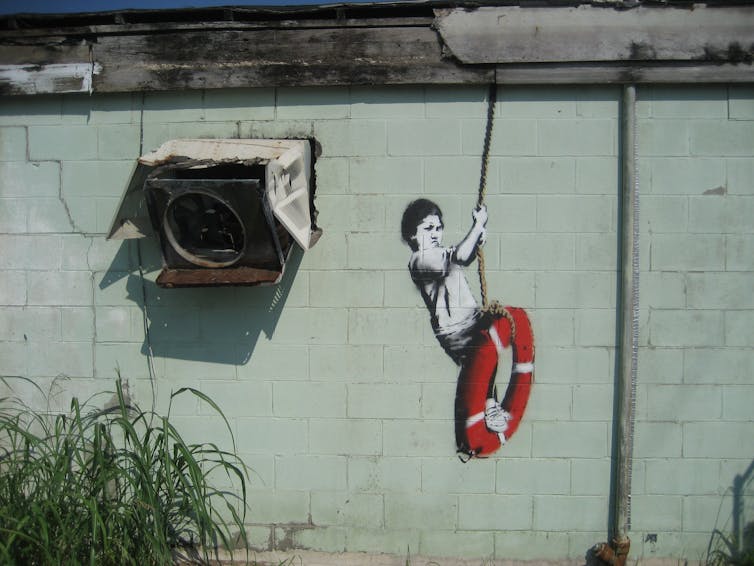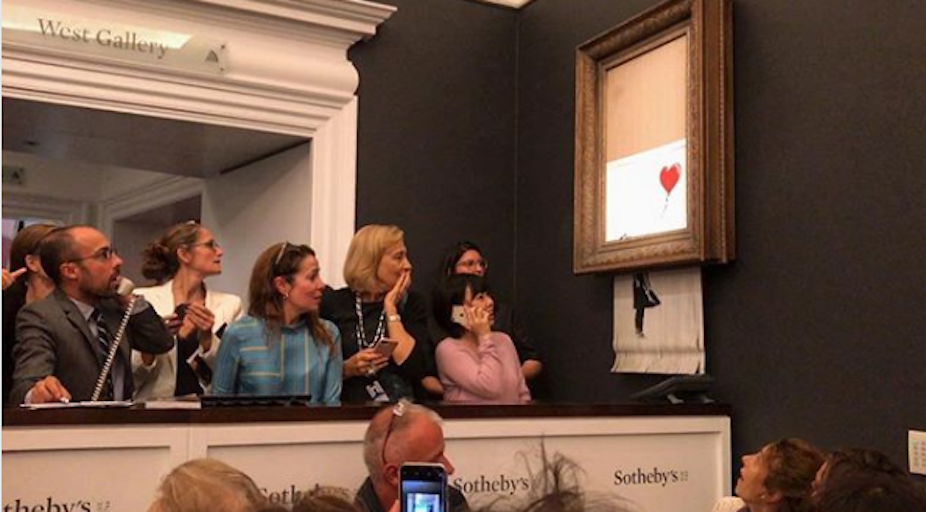Serious collectors of contemporary art had already started to leave the room at the Sotheby’s New Bond Street auction house in London last Friday night as a successful evening sale drew to a close. Most people seemed more interested in getting to their post-auction dinners than in the final two lots: paintings by KAWS and Banksy, who are generally perceived to be interesting for new or young buyers but not serious collectors. KAWS, the American graffiti artist also known as Brian Donnelly, is seen as too comic; Banksy as too “street”.
That doesn’t mean they are not in high demand. KAWS’ large yellow comic face, Again and Again, sold for just over £1m, making him – in the words of auctioneer Oliver Barker – the Damien Hirst of the 21st century. And the last lot of the sale was Banksy’s 2006 Girl with Balloon, which was last year named in one survey as the UK’s favourite artwork.
Unsurprisingly, bidding was intense and the hammer came down at £860,000, making a final sales price (including buyer’s fees) of £1,042,000 – quadrupling the previous estimate of the work. But the moment after the hammer came down a faint alarm went off in the room and, shortly after, in front of a roomful of gawping faces, the canvas slipped out of the frame, being shredded in the process by some concealed machine, before being hurriedly carried away by attendants.
Under near chaotic circumstances, the sale ended. At the delayed press conference, all Sotheby’s experts would say was: “We got Banksy-ed”. And all they did was to reiterate that they had no prior knowledge of the prank, failing to shift attention away from it.
Performance art
In our media crazy society, everyone likes a prank – especially when it hits the top end of the art market which excludes all but the very rich. So to nobody’s surprise this story has gone viral, cheered on by Banksy’s “official” Instagram feed, where he not only claimed ownership of the prank, but also “documented” its genesis.
Since then, speculation around the value of the shredded piece and Banksy’s role in the art world has led to a lot of hype. But what needs to be considered here is not only value generation in the art market but ultimately the role and agency of the artist within the market’s resale structure, where artists usually benefit only marginally from the resale of any of their works. That the stunt happened during the Frieze Art Fairs, one of the most important art fairs for contemporary art worldwide, has also given it added currency.
As a case study, the prank has been so successful that it will occupy the art world – as well as academics and students of the art market – for a long time to come. It might even become art history’s most famous stunt. Who are the involved parties, for example? Despite a great deal of speculative comment, I don’t think Sotheby’s was in on the game. The story really doesn’t benefit them; it detracted from all the other good news the evening was supposed to spread.
At this point, Sotheby’s is still claiming – and it does sound plausible – not to have touched the work or its frame, following the instructions of Banksy’s studio that the frame is an integral part of the work. Again, not unusual. Neither does the inclusion of the piece in the auction come as a surprise. As a quick search on Artnet’s price database shows, no less than 26 works by Banksy have been offered this year alone at auction – most of them with very good results above estimates. Banksy is hot.
So the fact that the work sold for more than £1m is not surprising, considering both the previous auction prices of the artists and the buoyant atmosphere of the sale that evening.
More interesting, of course, is what the work is worth now. Despite excitement by the press, claiming that it would now be worth far more (and what appears to be a copycat attempt by a collector to shred his own print copy of the painting), the case has not been decided contractually yet. In a comment to the author, the auction house states it is unclear whether the sale will go through and that negotiations are still ongoing. There is a debate to be had that the buyer obviously bid on a work in pristine condition – and we won’t know if the work is worth double its sale price until it has been sold again in this state.
It’s a tempting thought – and a terrific story – but an artist’s stunt and a weekend buzz are not a guarantor for ongoing investment value. It will, however, surely alert any auction house to ensure proper due diligence and conservation examinations when taking on more of his works.
Banksy’s brand
But where does Banksy stand, as someone who so happily seems to claim to stand outside the market? Given he is so against the resale of his work, has he attempted to sabotage more of his works? As mentioned above, his paintings as well as prints often come up at auction and have been an integral part of his output for years. For street artists who have become famous for often radical actions, the question of how to interact with a collector market has always been a challenge.

But one thing is for sure: if this was instigated by Banksy as a marketing stunt it was a big success. Even if the future of this particular Girl with Balloon is as yet unclear, Banksy’s name will be in everybody’s mind and his brand value has definitely risen.
So let’s wait and see what he will produce and sell next. In the meantime, the people cashing in on this story are also the so-called art experts who keep media outlets busy with comments – most of them, let’s not forget, unproven and highly speculative. And as such this story is a perfect image of the contemporary art market today – about money, but at least as much about the buzz.

